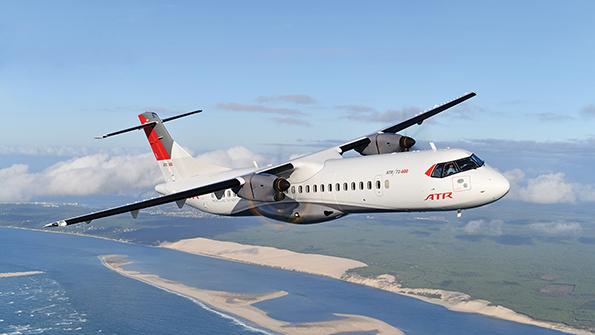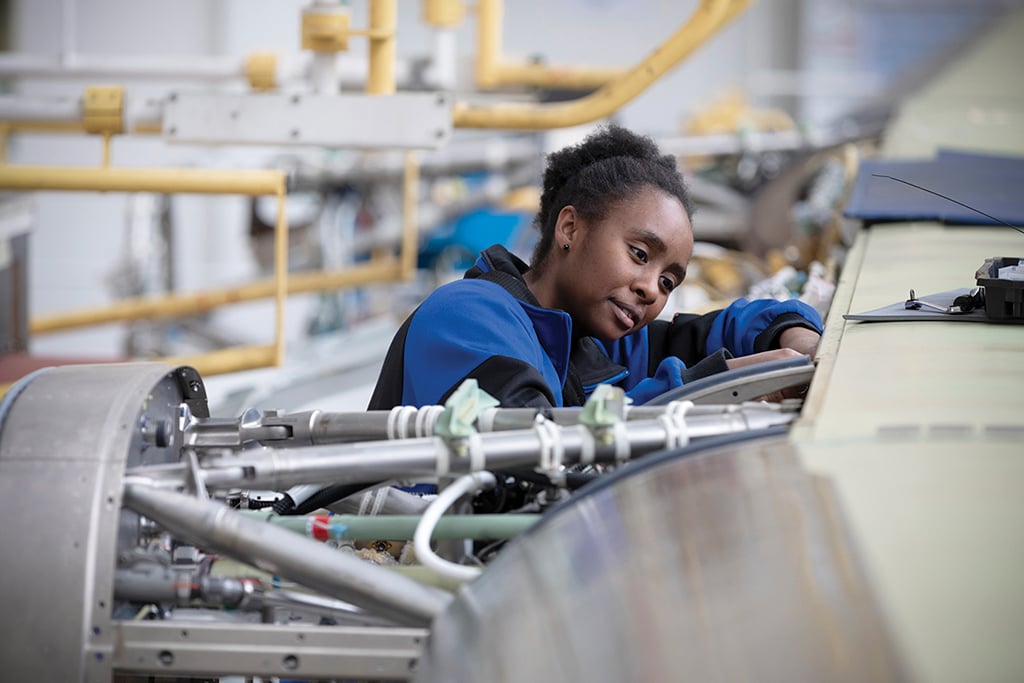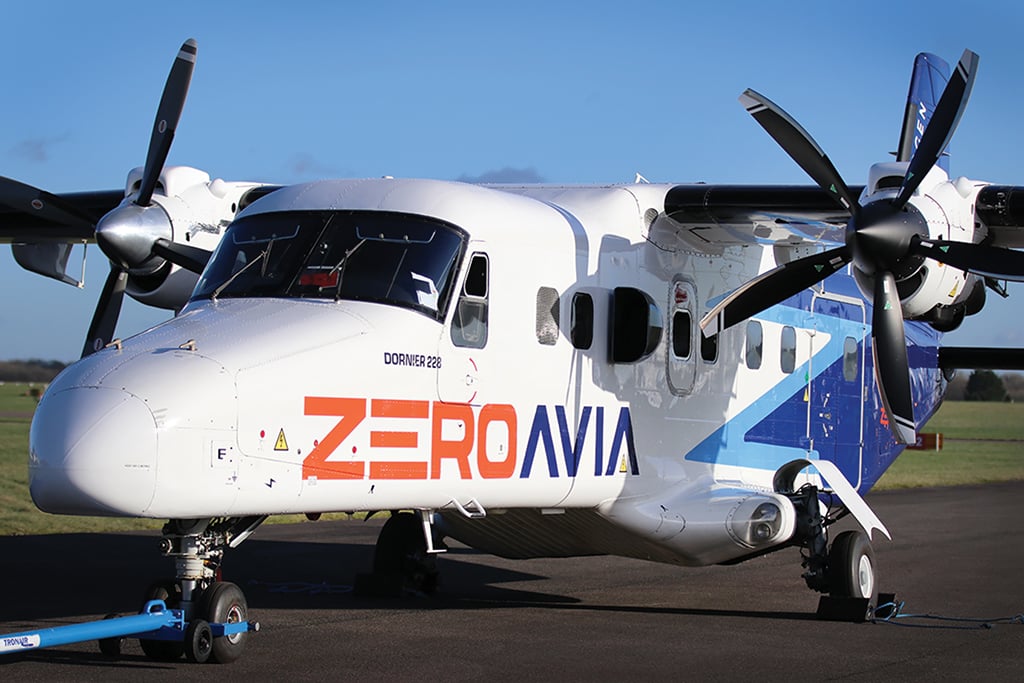Cargo Conversions, Alternative Propulsion Boost Turboprop Aftermarket

ATR predicts the turboprop MRO market will grow 5-7% in 2023-24.
During the decade before the COVID-19 pandemic, the turboprop market saw strong growth in traffic, demand and MRO requirements. In its most recent forecasts, airframer ATR sees a market for nearly 1,000 aircraft over the next two decades, driven mostly by growth in the Asia-Pacific region.
Slightly less than one-third of this is expected in China and another third from other countries in the region, where turboprops are seen as efficient aircraft for connecting smaller cities and islands within archipelago nations.
The pandemic and the resulting travel restrictions “had a significant impact on the industry, including on the MRO sector, as the decline in air travel and aircraft grounding inevitably led to a decrease in demand for maintenance, repair and overhaul services,” Stefano Marazzani, senior vice president for customer support and services at ATR, tells Inside MRO. “As airlines were forced to reduce their operations, some have cancelled or postponed their contracts with MRO providers. Many MROs had to reduce both their workforce and infrastructure.”
If the plummet in MRO demand caused by the lockdown was hard to manage, the spiky climb back up to resuming operations has involved a great deal of complexity. Regional variations as restrictions were lifted, changing travel dynamics and the altered work world have combined to create new modalities for interregional travel in particular.
“The challenge now for the MRO sector, as for the whole aviation industry, is to again increase capacity in order to meet the needs of a recovering airline market,” Marazzani says. “The ability to quickly recruit skilled professionals will be decisive, as well as the redefinition of an effective supply chain to offer the same efficiency to regional airlines operating turboprops [as] pre-COVID.”
CORE SIMILARITIES FOR MRO
MRO has been a challenge since the start of the pandemic in many regions, and turboprops offer some complexities—and benefits—in terms of maintenance compared with larger or similar size jet aircraft.
When it comes to performing MRO in general, “the major difference is in the overall size of aircraft,” says Petr Dobersky, CEO of Czech MRO provider Czech Airlines Technics (CSAT). “This is beneficial to turboprops due to hangar space requirements. Also, ground support equipment is not required for areas reachable from ground level. Otherwise, all base maintenance processes are common to turboprops and jets.”
Other commonalities include that “maintenance tasks are similarly driven by flight hours, cycles or calendar time,” Dobersky explains. “All manufacturers are slowly escalating the inspection interval over the course of decades of operation. From this perspective, these trends are equal for props and jets.”
Compared with mainline jets, the turboprop’s smaller size and lower-to-the-ground profile is an advantage, making some MRO procedures less cumbersome, although the high-wing structural element for modern turboprops minimizes these advantages when it comes to both wings and powerplants.
By and large, rather than a jet-versus-turboprop dividing line, “the differences are between older and new designs of airframes and systems—for example, fly-by-wire and composite structures,” Dobersky explains.
More widely, production and supply chain issues with recent generations of narrowbody jets in particular have created demand pressure on the turboprop fleet as potential replacements. But here, too, the end-of-line production of several turboprop aircraft, particularly in the under-70-seat market, has created limitations. Taken together, this drives a substantial amount of life-extension MRO work for older turboprop aircraft.
Overall, Marazzani says the turboprop MRO market is growing substantially. “We foresee a growth of the MRO market this year and in 2024 5-7% and then an average growth of at least 3%, with notable differences between airframe, components and engines markets,” he says.
The shift in airline preferences toward a comprehensive services model for MRO is set to continue, from the largest turboprop operators such as Lion Group, Qantas, WestJet’s Encore, Air New Zealand and Wideroe, down to the very smallest operating just a handful of aircraft.
“Despite these differences, some trends are being confirmed and increasing in comparison to the past, like the preference for airlines to have access to pools of spare parts and to select pay-by-the-hour programs for components, major elements and engine maintenance,” Marazzani says. “The reason is obvious: These contracts have proven to be more resilient than others during the pandemic, especially if linked to wide pools of parts, and with a direct link to manufacturers who were more inclined to invest in their products than independent organizations.”
Price, of course, remains a critical factor in the MRO market, and fluctuating prices for fuel also mean that facility location is crucial.

Perhaps even more than previously, “all operators are considering the price of positioning the aircraft to MRO [facilities],” CSAT’s Dobersky says. “Ideal cases are where some scheduled flight leads toward the MRO base and aircraft undergo the maintenance in the so-called ‘nose-to-tail’ manner. The swap of aircraft in and out of MRO can be accomplished by the same crew within a short ground time, and continuing scheduled flight operations resume immediately without extra costs.”
Given the often discrete route networks, hyper-regional operations and remote locations of turboprop operators, this type of positioning is not always possible, particularly for the many operators with fewer than half a dozen aircraft. For these airlines, moving aircraft to a suitable—and available—maintenance location can be an expensive exercise, especially if delays pop up.
“These complex logistics are organized to minimize the cost of ferry flights,” Dobersky explains. “From the perspective of turboprops and narrowbody jets, operators prefer the MRO within a distance of 2-3 flying hours from their bases. However, in the real world of the open market, the lack of MRO capacity or delicate maintenance tasks can justify much longer ferry flights.”
BALANCING OPERATIONS WITH OLDER AIRCRAFT
After years of standard passenger service, turboprops tend to be higher in cycles at a given age compared with jets, largely as a result of their shorter average sector lengths and commuter-focused operations. This makes them prime candidates for freighter conversion, where daily cycle requirements are often lower and cabin noise is not an issue.
“After many years as passenger aircraft, many aging ATRs are converted into freighters and begin their second life,” says Marazzani. “There are today around 130 converted freighters flying worldwide. Such an extension is beneficial for all parties—operators, lessors, integrators and ATR.”
Cargo and combi flights have long been a hallmark of turboprop operations in rural and remote areas, and factory-fresh cargo and combi aircraft are seeing renewed demand. The development of short-takeoff-and-landing versions of production aircraft is also stimulating this kind of demand.
“Cargo conversions are considerably increasing for turboprops,” Dobersky notes. “Availability of used aircraft on the market and ease of conversion of ATR [aircraft] already equipped with a cargo door we see as a current trend.”
OEM-provided conversions are another alternative, with De Havilland Canada offering Dash 8-400 conversion kits with cargo combi, package freighter, quick-change and freighter-large cargo door options.
A SUSTAINABLE FUTURE
As aviation works to meet its carbon-reduction commitments, the substantially lower emissions of turboprop aircraft are already attractive.
“In general, turboprops should be regarded as more of a choice when battling aviation’s emissions in the near future, as they are much more CO2-efficient than comparable jet aircraft and will not result in significantly longer flight times on many regional routes,” says Lukas Kaestner, co-founder and chief commercial officer of the Sustainable Aero Lab in Hamburg.
The lab’s recent white paper, “Bridging the Gap to 2050: How to Decarbonize Aviation Faster With Today’s Technologies,” highlights turboprops as one of three main pathways to near-term emissions reduction, alongside—and in some cases combined with—accelerating introduction of sustainable aviation fuel (SAF) and creating a clear regulatory framework for fleet renewals.

“The turboprop market is a very interesting one right now,” Kaestner says. “This segment is most likely to see any technological breakthroughs become a reality first. The successful flights by ZeroAvia with a retrofitted Dornier Do 228 and Universal Hydrogen with a retrofitted Dash 8 and ATR in the pipeline for hydrogen show this.”
The use of turboprops as first-generation testbeds for alternate power sources such as hydrogen turbines, hydrogen fuel cells, battery-electric power and hybrid systems only adds to their attractiveness.
“Hydrogen-electric, zero-emission engines have a massive opportunity to extend the lifespan of turboprops flying today and create a renaissance for these aircraft generally,” ZeroAvia Chief Customer Officer James Peck says. “Driving demand for the switch to fuel-cell propulsion is both the opportunity to slash the climate impact of flight operations and to substantially reduce operating costs thanks to lower cost of fuel and reduced maintenance costs.”
Not only will the turboprop market segment be critical for decarbonizing shorter-distance flying, it will also be an important proving ground for scaling up live trials of an entire generation of new technology, including for MRO.
“We have more than 1,500 power-train preorders and a certification timeline of 2025 and 2027 for our first two engines, so we are actively developing our MRO model,” Peck notes. “We have already signed an agreement with AFI KLM E&M to assess the training needs that will be required for technicians involved in retrofit and maintenance, to explore data analytics and prognostics and to work toward possible retrofit and MRO partnerships to support ZeroAvia powertrains globally.”
“A revamped 40-seater with an option for hydrogen propulsion as well as 100% SAF is on the horizon [at Deutsche Aircraft],” Kaestner notes. “[That] is particularly interesting, as the market for 30-ish-seater turboprops is pretty much empty right now.”
Embraer’s Energia family of hybrid, fuel-cell and dual-fuel SAF/hydrogen rear-engine, low-wing turboprops are designed to fill this market gap. With hybrid-electric 19- and 30-seaters planned to begin flying in 2030, fuel-cell airpower at the same capacity expected in 2035, and dual-fuel gas turbines with 35-50-passenger capacity planned to start in 2040, it is clear the MRO sector needs to adapt to new technology.
“We are currently studying the feasibility to launch [our] EVO aircraft concept based on mild hybridization, embodying new technologies to boost efficiency, with 100% SAF capability,” ATR’s Marazzani says. “This will be a first step that will not have a huge impact for MROs, as this will only be an evolution of our current platform, ensuring availability of maintenance, repair, modification and overhaul competencies.
“We anticipate that the turboprop MRO market will therefore evolve slightly in the next few years, as the maintenance of older and not-in-production aircraft will generate additional maintenance volumes,” he continues. “But the greatest change will happen around 2030, when new aircraft types enter the market with new technologies, mainly driven by the need to decarbonize aviation and limit its impact on climate change.”




